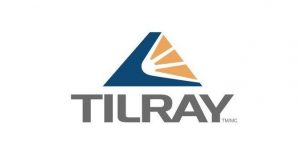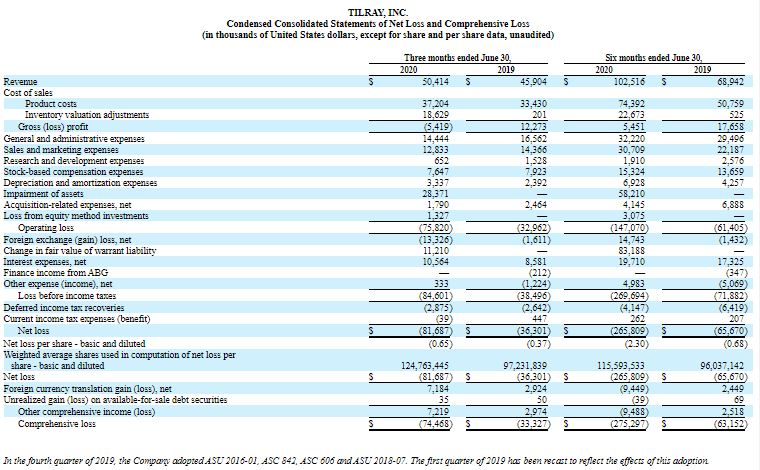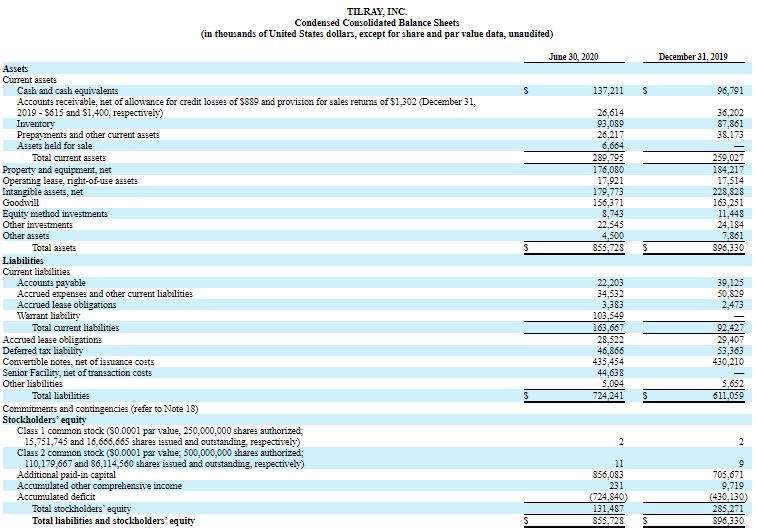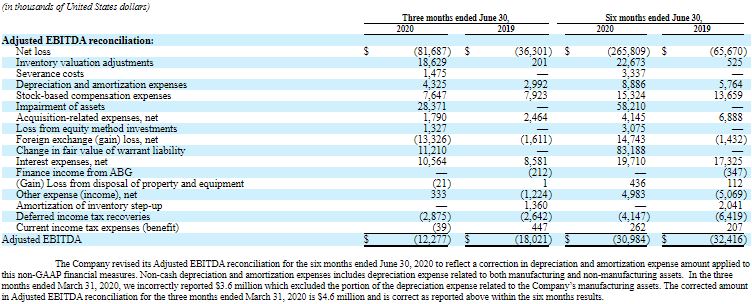
Tilray, Inc. Reports 2020 Second Quarter Results
- Revenue Increased 10% to $50.4 Million (C$69.4 Million) versus Q2 2019
- Cost Savings of $13.0 Million Realized in Q2 2020 – on Pace for Total Annualized Savings of Approximately $55 Million
- Net Loss of ($81.7) Million increased $45.4 Million versus Q2 2019 Partially Due to Facilities Closure and Inventory Adjustments
- Adjusted EBITDA Loss of ($12.3) Million Represents 32% Improvement compared to both Q2 2019 and Q1 2020
- $137 Million Q2 2020 Ending Cash Balance and $250 Million Remaining on ATM
NANAIMO, British Columbia, August 10, 2020–(BUSINESS WIRE)–Tilray, Inc. (“Tilray” or the “Company”) (Nasdaq: TLRY), a global pioneer in cannabis research, cultivation, production and distribution, reports financial results for the second quarter ended June 30, 2020. All financial information in this press release is reported in U.S. dollars, unless otherwise indicated.
“Since the beginning of 2020 we have taken bold and significant actions to position Tilray for future growth and success. We have focused on reducing costs, driving international revenue growth, mitigating COVID-19 related challenges, and improving our net loss and reported Adjusted EBITDA. Today’s results demonstrate significant progress in all these areas.
Despite a challenging business environment, we generated healthy year-over-year revenue growth, we significantly reduced our cost structure and cash burn, and we improved our Adjusted EBITDA and net loss compared to both the prior quarter of 2019 and the first quarter of 2020. We are particularly encouraged by the revenue growth of our International Medical business during the second quarter. International Medical revenues now exceed those of our Canadian Medical business and we anticipate growth in this segment to outpace our other segments in the coming quarters.” said Brendan Kennedy, Tilray’s Chief Executive Officer.
With our significant cost cutting and balance sheet actions behind us, we have positioned Tilray to enter the second half of 2020 in a stronger position so we can remain focused on achieving profitable growth in all our markets and deliver break-even or positive Adjusted EBITDA in the fourth quarter of 2020.
 Brendan Kennedy, Tilray’s Chief Executive Officer
Brendan Kennedy, Tilray’s Chief Executive Officer
Second Quarter 2020 Financial Highlights
- Revenue increased 10.0% to $50.4 million (C$69.4 million), compared to the second quarter of 2019. Growth was driven by a 16.2% increase in cannabis sales, particularly from ongoing improvement in International Medical, while Manitoba Harvest hemp products sales increased 1.6%.
- Revenue decreased 3.2% compared to the first quarter of 2020 generally driven by a 15.8% decrease in Adult Use sales, a 5.3% decrease in Canada Medical sales, and a 5.1% decrease in Hemp sales, partially offset by a 43.2% increase in International Medical sales. Sequential sales declines in Adult Use and Canada Medical were largely attributable to the impact of COVID-19, specifically; pantry-loading in March, the temporary closure of stores in Ontario, changes in purchasing behavior by the provinces, the shift to curbside pickup or delivery, and the limited number of retail locations added during the second quarter of 2020.
- Total cannabis kilogram equivalents sold increased 105% to 11,430 kilograms from 5,588 kilograms in the second quarter of 2019. Total cannabis kilogram equivalents sold increased 84% to 10,294 kilograms from 5,588 kilograms in the second quarter of 2019. The increase was primarily due to a one-time Bulk transaction associated with the termination of a supply contract.
- Average cannabis net selling price per gram decreased to $2.64 (C$3.59) compared to $4.61 (C$6.26) in the second quarter of 2019 and $5.28 in the first quarter of 2020. The decrease was driven by a one-time Bulk transaction associated with the termination of a supply contract. Excluding the one-time transaction, average net selling price increased to $5.03. The increase was due to a continued shift towards International Medical sales, and higher potency and higher priced products in the Adult Use market.
- Average cannabis net cost per gram decreased to $2.06 (C$2.80) compared to $3.86 (C$5.24) in the second quarter of 2019 and $3.97 (C$5.39) in the first quarter of 2020. The decrease was driven by a one-time Bulk transaction associated with the termination of a supply contract. Excluding the one-time transaction, net cost per gram decreased to $3.42. The year over year decrease is primarily a result of reduced cost structures at our facilities due to our cost cutting efforts, better throughput and cost absorption at our High Park Holdings processing facility, and partially due to the availability of low cost product available from third parties.
- Gross margin decreased to (10.7)% from 27% in the second quarter of 2019 and 21% in the first quarter of 2020. In the second quarter of 2020, the we took an inventory write-down of $18.6 million.
- Gross margin, excluding inventory valuation adjustments, decreased to 26% from 27% in the second quarter of 2019 and 29% in the first quarter of 2020. The decrease was partially due to introductory shipments made at lower margins in International Medical and a one-time Bulk transaction associated with the termination of a supply contract.
- Gross margins for cannabis, excluding inventory valuation adjustments, decreased to 10% from 14% in the second quarter of 2019 and 20% in the first quarter of 2020.
- Gross margin for hemp, excluding inventory valuation adjustments, decreased to 50% from 51% in the second quarter of 2019 and increased from 41% in the first quarter of 2020. The sequential increase in gross margin is largely attributable to the timing of discount programs offered to Tilray’s largest customer.
- Net loss increased $45.4 million to ($81.7) million, or ($0.66) per share, compared to net loss of ($36.3) million, or ($0.37) per share, in the second quarter of 2019. The increased net loss was primarily due to a $18.6 million inventory valuation adjustment, a charge of $28.4 million for impairment of assets, $11.2 million impact of the change in fair value of warrant liability, offset by $13.3 million of foreign exchange gains due to the strengthening of the Canadian dollar.
- Adjusted EBITDA loss of ($12.3) million was 32% better than the ($18.0) million loss in the second quarter of 2019. The Adjusted EBITDA improvement was largely due to higher revenues in all channels, and reduced expenses.
- Adjusted EBITDA loss in the second quarter of 2020 was a 34% improvement compared to the ($18.7) million loss in the first quarter of 2020. The reduced loss was generally due to significant cost reductions and operating efficiencies despite moderately lower revenues attributable to COVID-19 impacts.
- We ended the second quarter of 2020 with $137.2 million in cash and cash equivalents. We believe our existing cash balance, reduced cash burn, and our access to the remaining $250 million on our ATM provide sufficient capital and access to capital to manage operations and execute our plans for the remainder of 2020 and well into 2021.
Update to Board of Directors
Maryscott Greenwood intends to resign as a member of our board of directors and all committees thereof, effective as of September 30, 2020. The Company is grateful for Ms. Greenwood’s contributions to Tilray.
Effective August 6, 2020, Soren Schroder has been appointed as a Director on the Tilray Board. Soren has served in a variety of agribusiness leadership roles in the United States and Europe. After working for more than 15 years at Continental Grain and Cargill, he joined Bunge Ltd in 2000. Soren served as CEO of Bunge North America, leading Bunge’s business operations in the United States, Canada, and Mexico. In June 2013, he was named CEO of Bunge Ltd, serving in this role until 2019. Soren is active in board and advisory roles for emerging companies in the agribusiness and food sectors. His experience lies in building global supply chains, managing risk, logisitics, industrial and value-added activities, and executing on strategy via acquisitions and partnerships on a global scale. Soren is a Danish National and earned a BA in Economics from Connecticut College.
COVID-19 Business Continuity Measures
Since the outset of the global health pandemic, we have remained committed to the health of our employees. We continue to adhere to the regulations outlined by governments and health regulators in all markets in which we do business. Our business continuity plan remains in effect across all offices and facilities to ensure the health and safety of its workforce, consumers, and the communities in which it operates.
We have experienced moderate impacts to our Adult Use revenue and Canadian medical, but no material impact to our operations as a result of the COVID-19 pandemic. While we remain committed to serving our patients and consumers around the world, due to the uncertainty presented by COVID-19 and its potential impact on the our patients, customers, supply chain, markets, employees, and the potential broader ramifications to the global economy, financial markets, and government institutions, we may experience material effects to our business, results of operations and financial condition.
Conference Call
The Company will host a conference call today, August 10, 2020, to discuss these results at 5:00 p.m. ET. Investors interested in participating in the live call can dial 877-407-0792 from the U.S. and 201-689-8263 internationally.
There will also be a simultaneous, live webcast available on the Investors section of the Company’s website at www.tilray.com. The webcast will also be archived after the call concludes.
About Tilray®
Tilray (Nasdaq: TLRY) is a global pioneer in the research, cultivation, production and distribution of cannabis and cannabinoids currently serving tens of thousands of patients and consumers in 15 countries spanning five continents.
Use of Non-U.S. GAAP Financial Measures
To supplement its financial statements, the Company provides investors with information related to Adjusted EBITDA and Gross margin, excluding inventory valuation adjustments, which are financial measures which are not calculated in accordance with generally accepted accounting principles in the United States (“U.S. GAAP”).
Adjusted EBITDA is calculated as net income (loss) before inventory valuation adjustments; interest expenses, net; other expenses (income), net; deferred income tax (recoveries) expenses, current income tax expenses (benefit); foreign exchange gain (loss), net; depreciation and amortization expenses; other stock-based related compensation expenses; loss from equity method investments; finance income from ABG; loss on disposal of property and equipment; acquisition-related (income) expense; amortization of inventory step-up; severance costs; impairment of assets; and change in fair value of warrant liability. A reconciliation of Adjusted EBITDA to net loss, the most directly comparable GAAP measure, has been provided in the financial statement tables included below in this press release. Gross margin, excluding inventory valuation adjustments, is calculated as revenue less cost of sales adjusted to add back inventory valuation adjustments and amortization of inventory step-up, divided by revenue. A reconciliation of Gross margin, excluding inventory valuation adjustments, to gross margin, the most directly comparable GAAP measure, has been provided in the financial statement tables included below in this press release.
The Company believes these non-GAAP financial measures provide useful information to management and investors regarding certain financial and business trends relating to the Company’s financial condition and results of operations. Management uses these non-GAAP financial measures to compare the Company’s performance to that of prior periods for trend analyses and planning purposes. These non-GAAP financial measures are also presented to the Company’s Board of Directors.
Non-U.S. GAAP measures should not be considered a substitute for, or superior to, financial measures calculated in accordance with U.S. GAAP. Non-U.S. GAAP measures exclude significant expenses that are required by U.S. GAAP to be recorded in the Company’s financial statements and are subject to inherent limitations.






